Translate this page into:
Sensitivity analysis and application of single-valued neutrosophic transportaion problem
⁎Corresponding author. kavinphd@gmail.com (K. Kavitha)
-
Received: ,
Accepted: ,
This article was originally published by Elsevier and was migrated to Scientific Scholar after the change of Publisher.
Abstract
The neutrosophic set serves as a powerful tool for addressing complexity, ambiguity, and managing imperfect and inconsistent information in the digital world. Graph theory plays a crucial role in determining the shortest path for neutrosophic sets through graph algorithms. This article introduces a novel algorithm, the bipartite graph contraction algorithm, to elucidate the graphical aspects within neutrosophic set theory by using score function for ranking. The proposed bipartite neutrosophic graph contraction algorithm is applied to solve a single-valued neutrosophic network, where the transportation unit cost is expressed as a trapezoidal single-valued neutrosophic number and produced the result as . A comparative analysis with an existing algorithm is conducted, and a novel introduction of sensitivity analysis in the realm of neutrosophic set theory is presented to assess the optimality of the result in neutrosophic transportation problems.
Keywords
Score function
Trapezoidal Single-valued neutrosophic network
Bipartite neutrosophic graph
Sensitivity analysis
Optimum solution
05C72
00A79
49Q22
05C85
05C90

Nomenclature
- SP
-
Shortest Path
- FS
-
Fuzzy Set
- IFS
-
Intuitionistic Fuzy Set
- NS
-
Neutrosophic Set
- NTP
-
Neutrosophic Transportation Problem
- TP1
-
Transportation Problem – Type 1
- SVNS
-
Single-Valued Neutrosophic Set
- SVN
-
Single-Valued Neutrosophic
- SVNLPP
-
Single-Valued Neutrosophic Linear Programming Problem
- BNGCA
-
Bipartite Neutrosophic Graph Contraction Algorithm
- TSVNTP
-
Trapezoidal Single-Valued Neutrosophic Transportation Problem
- TSVNN
-
Trapezoidal Single-Valued Neutrosophic Number
- TSVNLPP
-
Trapezoidal Single-Valued Neutrosophic Linear Programming Problem
- DM
-
Decision Maker
- SA
-
Sensitivity Analysis
Data availability statement
The data used for this paper analysis has been included and cited within this paper. The digraphs are drawn manually according to the proposed algorithm.
1 Introduction
Utilizing network models is a highly effective approach for addressing various decision-related issues, as many problems can be accurately and efficiently modelled as network optimization problems. Network analysis and network flow theory constitute a well-researched area of optimization, with substantial connections to diverse fields such as combinatorial mathematics, algebraic topology, and circuit theory. Vella (2005) laid the ground work for introducing topological characteristics to graph theory. Aljanabi and Jasim (2015), published a strategy for solving transportation problems using a modified Kruskal's algorithm. Santhi and Eswarasamy (2019), proposed a topological solution to a transportation problem using a topologized graph. Vimala and Kalpana (2017), introduced the Bipartition Graph concept and applied it to graph matching and coloring.
According to Zadeh (1965) fuzzy set theory, each element's level of involvement in an ambiguity problem is represented by a degree of membership function. Smarandache (1998) in neutrosophic logic, a proposition has degrees of membership functions for truth (T), indeterminacy (I), and falsity (F). Smarandache (1998) initially formulated the concept of a neutrosophic probability set and logic. Atanassov and Atanassov (1999), the extension of a fuzzy set and the intuitionistic fuzzy set gives rise to the concept of a neutrosophic set and the concept of a NS serves as a generalization of fuzzy set theory, Atanassov and Gargov (1989), intuitionistic fuzzy set theory, and Turksen (1986) interval-valued intuitionisitic fuzzy set theory. Smarandache (2010), NS involve only truth, indeterminacy, and falsity membership degrees, encapsulated within the standard or non-standard unit interval [−0, 1+]. Dijkstra’s (1959) delivered two problems with solutions using graphs.
In a related context, Ekanayake et al. (2021), utilized the graph contraction technique for balanced transportation problems to identify the shortest path in transportation network problems with limited iterations. Furthermore, Johnson et al. (2018), applied the bipartition graph concept, finding the shortest path for Linear Programming Problems (LPP) by transforming a bipartite graph with both balanced and unbalanced TP.
Kavitha and Pandian (2012), investigated the Type II sensitivity analysis for assignment problems in solid transportation, through illustrative examples. Thamaraiselvi and Santhi (2016), proposed a novel approach to determining the optimal value in a real-world transportation problem within a neutrosophic framework, employing the VAM method. Souhail Dhouib (2021), introduced an innovative method, named as Dhouib matrix-TP1, to address a single-valued NTP where transportation unit costs are represented as trapezoidal neutrosophic numbers, and supply and demand are treated as unit costs. Wang et al. (2010), presented a design for SVNS through theoretical proof. Wang and Zhang (2018), discussed about two SVNS covering rough sets and its application to decision making problems. Broumi et al. (2016a,b,c,d), The characteristics of SVN graphs and score functions, as well as their application in isolated SVN graphs, were elucidated in their works.
Kandasamy et al. (2015), regarding the fundamental definitions, characteristics, and outcomes associated with neutrosophic sets, specifically focusing on the definitions of single-valued neutrosophic sets and bipartite neutrosophic graphs. Broumi et al. (2016a,b,c,d), conducted a theoretical examination in their work, exploring the degree, order, and size of SVN graphs and detailing their determination through score functions and ordering based on fundamental definitions. In another contribution, Broumi et al. (2016a,b,c,d), proposed computational concepts to address various issues in SVN networks, applying these concepts to determine the shortest path using a ranking approach. Additionally, Smarandache (2020), presented a study intended to guide researchers in implementing score, accuracy, and certainty functions, as well as calculating a total order on the set of neutrosophic triplets across various domain and also provided basic information and understanding of score function implementation in NS theory in detail. Kanchana and Kavitha (2024), presented about score functions that can be used for graph algorithms and proposed heuristic incident edge path algorithm for interval valued neutrosophic transportation problem for finding minimum cost in uncertain environment.
Smarandache and Pramanik (2016), New trends in neutrosophic sytems a editorial volume discusses; in practical applications within engineering and scientific fields, implementing the principle of a neutrosophic set proves challenging; The application of the neutrosophic set concept is particularly complex in natural, engineering, and scientific domains. Nevertheless, the neutrosophic set idea provides an effective means of handling uncertain, inadequate, incompatible, and inconclusive data more accurately; Due to this characteristic, neutrosophic set theory implemented in all fields to rectify the uncertainty.
1.1 Main contribution of the article
The main objective is to implement the graphical approach within NS theory via algorithms. While many algorithms are available for finding the shortest path for transportation networks, only a few have been applied and verified in the field of NS theory. To fill this gap, an algorithm is proposed and verified through an example. The BNGCA has been introduced and applied to the TSVNLPP and its running time complexity is also implemented through an example NTP. Through this technique bipartite neutrosophic graph effectively addresses the indeterminacy in transportation costs while ensuring certainty in supply and demand.
When addressing a Neutrosophic Transportation Problem – Type I (NTP-1), availability and demand are represented as real numbers, while the cost of conveying a unit quantity of merchandise is represented as a trapezoidal neutrosophic number. The score function is used to de-neutrosophicate the trapezoidal neutrosophic number into a crisp number for the calculation process and the monotonicity and boundedness of score and accuracy function is defined in preliminaries. BNGCA provides a novel approach within the field of NSs, providing spanning tree assignments for all supply and demand satisfactions. Its efficacy is validated through comparison with existing methods (Dhouib, 2021; Thamaraiselvi and Santhi, 2016) in NTP applications. Additionally, this article introduces sensitivity analysis for NSs, establishing maximum and minimum boundaries for unit transportation costs without compromising the optimality, thereby confirming the solution's effectiveness. SA offers a novel method for validating NTP solutions, demonstrating that the proposed method is effective compared to existing ones.
2 Preliminaries
Definition 1 (Dhouib, 2021): Consider to be a space of objects. The set is neutrosophic, containing an object defined by . The functions representing the degree of truth membership , degree of indeterminacy , and degree of falsity membership , respectively, in relation to set , with the conditions and .
Logically, the NS takes into account points from a real non-standard or standard subset. However, for practical applications, especially in technological disciplines, the interval is often utilized, because it is more possible to apply in real-life settings such as engineering and scientific network difficulties.
Definition 2 (Atanassov and Gargov, 1989): Consider as a universe of discourse containing global objects denoted by . A single-valued neutrosophic set is defined by the global elements of a set . The SVNS is represented as , where are the degrees of truth, indeterminacy, and falsity membership respectively.
Definition 3 (Dhouib, 2021): Let
, be a trapezoidal single-valued neutrosophic number, and the truth, indeterminacy, and falsity membership functions
are defined as follows,
Eq. (10) is used to de-neutrosophication of TSVNN to compare the edge weights. The boundedness and monotonicity of Eqs. (10) and (11) are defined as follows;
Monotonicity:
-
increases depending on
-
increases as increases and increases as decreases
-
increases as minimum of increases.
-
increases as is monotonic.
Boundedness:
-
and are not constrained to
-
is not naturally bounded since adding up minimum of which give rise to unbound.
The score and accuracy functions are normalized to make the boundedness within the range [0, 1]. Monotonic behaviour of both score and accuracy remains unchanged before and after normalization. For NS theory it is not strictly necessary that the accuracy must be within [0, 1] range. Since, it involves sum of weights, costs, distance, etc., and the truth, indeterminacy and falsity membership values have the range in total as [0, 3] (refer definition 1).
Example: Consider the following TSVNN,
The score value and accuracy values as follows,
and normalized score value.
for .
Throughout this article we use before normalization for changing TSVNN into crisp data only.
Definition 6 (Kandasamy et al., 2015): Let be a neutrosophic graph and is partitioned into two neutrosophic sub graphs such that.
and . A graph is said to a bipartite neutrosophic graph if admits a partition into two sub graphs such that each edge has one end in and another end in .
2.1 Parameters of transportation problem
i – number of sources.
j- number of destinations.
– the number of products transported from source to destination in units.
– total supply of products at source i.
– total demand of products at destination j.
2.2 Mathematical formulation
Consider as the source and as the destination of the transportation problem. Let us consider the parameters for the problem as the number of products for transportation and the indeterminate cost the unit cost of quantity transferred from supply to demand. The formation of transportation problem is defined by,
Subject to the supply constraints
Demand constraints
The following proposed algorithm was applied to a balanced TP with balanced constraints , with indeterminacy in unit transportation costs and certainty in supply and demand values.
3 Algorithm: Bipartite neutrosophic graph contraction algorithm (BNGCA)
Step 1: Convert the LPP into a balanced transportation table with supply and demand. If it is not balanced, then balance the TP by adding dummy rows or columns to supply or demand, as needed. Use the score function to de-neutrosophicate the trapezoidal single-valued neutrosophic network's edge weights.
Step 2: Draw a bipartite neutrosophic graph for the balanced TP with de-neutrosophicated edge weights connecting supply and demand.
Step 3: Choose two minimum unit transportation costs (edge weights) from the bipartite neutrosophic graph connecting supply and demand.
Step 4: Pick the least edge weight with maximum supply and demand, and allocate to the respective edge depending on which has the minimum supply or demand.
Step 5: Remove edges connected to fully satisfied supply or demand nodes. Ensure the bipartite graph’s structure remains valid after the removal of edges.
Step 6: Repeat the process from Step 4 until all allocations are made and no edges remain.
3.1 Illustration
3.1.1 Trapezoidal single valued neutrosophic transportation problem
Let us assume a transportation problem in the shoe manufacturing process. Initially, the leather needed for making shoes must be collected from three sources namely and , delivered to four manufacturing industries located in different areas through transports and respectively. The TP involves trapezoidal neutrosophic supply, demand, and unit transportation costs, the problem is to calculate the optimum cost of delivering leather to the manufacturing industries at a minimum transportation cost.
Linear Programming Problem with supply and demand constraints,
Supply constraints
Demand constraints
3.1.2 De-neutrosophicated TSVNTP
The neutrosophic numbers of unit transportation costs are de-neutrosophicated using the following equation
The de-neutrosophicated unit transportation costs of TP1 are displayed in Table 1. The NTP has been drawn as a bipartite neutrosophic graph, shown in Fig. 1, to apply the proposed algorithm.
Supply
3
7
10
26
1
3
6
4
24
5
2
3
3
30
Demand
17
23
28
12
80
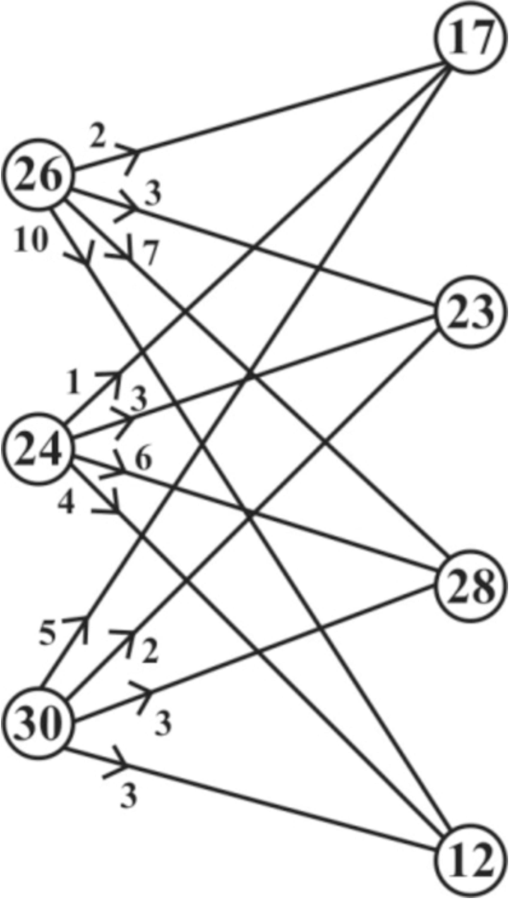
Bipartite neutrosophic graph with de-neutrosophicated edge weight.
Figs. 2–4 illustrate the procedural steps of the proposed algorithm and the solution is obtained by BNGCA,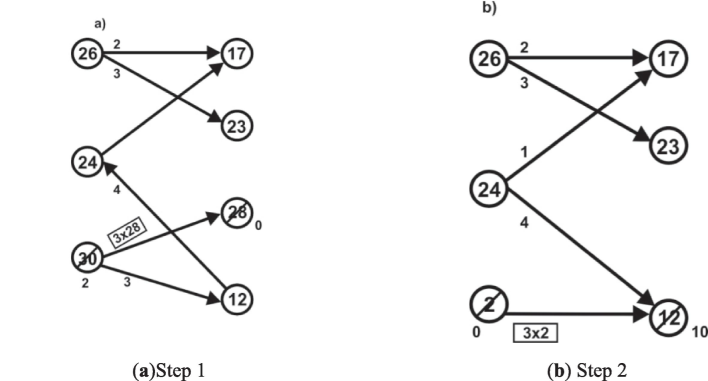
(a) Step 1, (b) Step 2.
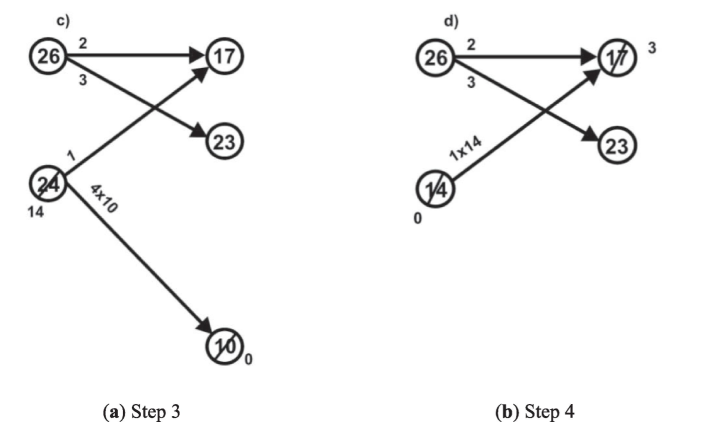
(a) Step 3, (b) Step 4.
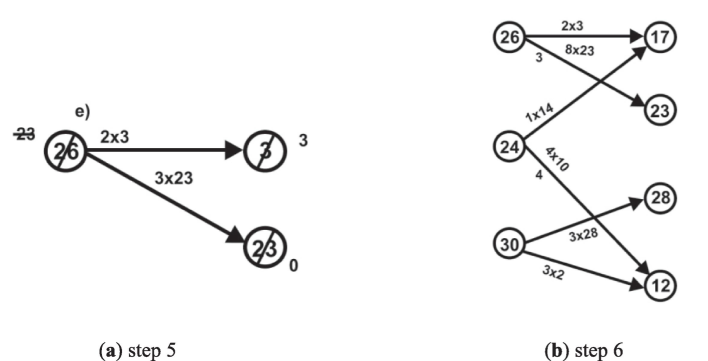
(a) step 5, (b) step 6.
Step 6 forms a spanning tree with bipartite conditions, which provides the optimum result for the neutrosophic network, and leading to the final solutions, such as are the optimum solution being a minimum of
3.2 Sensitivity analysis for TSVNTP
The principles applied in the BNGCA for TP1 approach to determine the cost sensitivity ranges for all basic and non-basic variables in the considered trapezoidal single-valued neutrosophic transportation allocation problems are sourced from (Kavitha and Pandian, 2012) are as follows:
Theorem 1. Consider cell as a non-basic cell corresponding to an optimal SAP solution . If the unsettled cost of , then the range of this cost is given by
Theorem 2. Consider cell as a basic cell corresponding to an optimal SAP solution . If is the perturbed value of and is the minimum value of for all non-basic cells in the th origin, is the minimum value of for all non-basic cells in the th destination, then in the range of where is the maximum of
Proof of theorem 1. Now, since cell is a non-basic cell and the perturbed cost is not affected by the current optimal solution to the problem, . It implies that, . Therefore, the range of Hence, the theorem.
Proof of theorem 2. Now, we know that is the perturbed value of and the current optimal solution remains optimal , all non-basic cells in the th origin and the th destination are positive.
Now, attaching with first , we have the following:
is non-basic cells,
are non-basic cells,
Thus, we can conclude, based on the above implications that
Now, since we attach one of the MODI indices, we take = maximum for getting a better range. Therefore, the range of . Hence, the theorem.
3.2.1 SA for the optimal bipartite neutrosophic network
The analysis is conducted based on theorems outlined in Section 3.2. As stated in the theorem, Tables 2 and 3 illustrates the type-1 sensitivity ranges for the unit transportation costs and objective values, specified in Table 1 for TSVNTP.
F1
F2
F3
F4
Supply
O1
26
O2
24
O3
30
Demand
17
23
28
12
80
F1
F2
F3
F4
Supply
O1
26
O2
24
O3
30
Demand
17
23
28
12
80
3.3 Comparative study between proposed BGNCA and existing methods
Based on these computations, the cost values are expected to range from 364 to 908, corresponding to the maximum unit transportation costs outlined in Table 1. Tables 2 and 3 outlines the maximum allowable increase in unit transportation costs.The presented algorithm successfully addresses the linear programming problem associated with TSVNTP, sourced from Thamaraiselvi and Santhi (2016) and Souhail Dhouib (Dhouib, 2021). A comparison was made between the outcomes generated by BGNCA and the conventional zero-point allocation technique (Thamaraiselvi and Santhi, 2016), as well as Dhouib-Matrix-TP1 (Dhouib, 2021). The BGNCA proves to be highly advantageous, providing solutions within a limited iterations for TP1. Moreover, it is both easily comprehensible and straightforward to implement.
Comparison between the existing methods and proposed BNGCA:
The neutrosophic basic feasible solution method –
Zero-point allocation by VAM –
Dhouib-Matrix-Tp1 –
Proposed BNGCA for TP1 –
Fig. 5 depicts the visual representation of membership functions for truth, indeterminacy, and falsity in the context of TSVNTP. The illustration suggests that, by appropriately managing budget constraints, DM can achieve optimal cost ranges spanning from 364 to 908, based on the membership degrees of truth, indeterminacy, and falsity.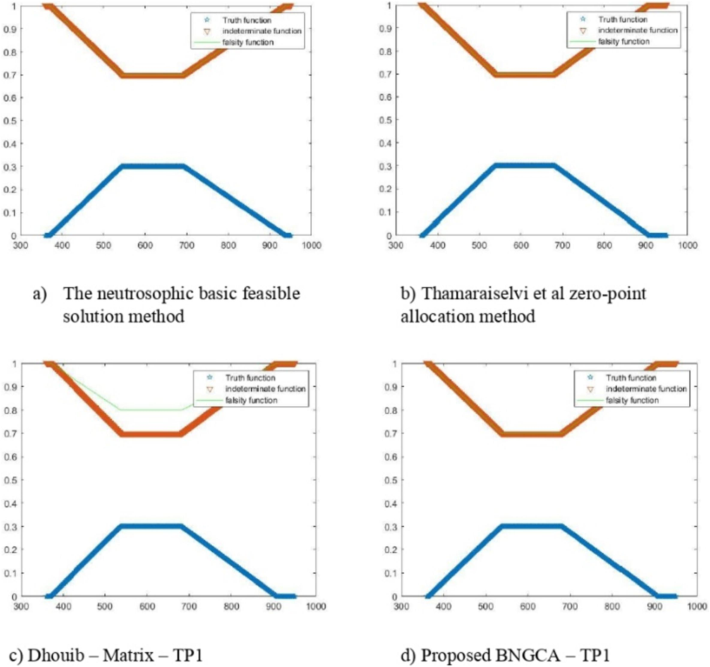
Graphical representation of membership functions of TSVNTP.
4 Results and discussion
The proposed BNGCA for obtaining the optimal solution in LPP is both distinctive and effective. Its simplicity makes it easily comprehensible, while the computational process efficiently determines the indeterminacy transportation cost of the TSVNN. This method, BNGCA, is applicable to all indeterminacy transportation costs in SVNLPP that satisfy the conditions of a bipartite graph. Comparatively, the optimal neutrosophic solution outperforms the Dhouib-matrix-TP1 (Dhouib, 2021). The analysis indicates that the total minimum unit transportation cost falls between values greater than 364 and less than 908, and between values higher than 537 and less than 694.
The degrees of truth, indeterminacy, and falsity membership are as follows: where is the degree of truthfulness, and a is the total cost,
In the referenced article (Thamaraiselvi and Santhi, 2016), the author employed the penalty and zero-point methods to determine the optimal cost. However, Souhail Dhouib challenged these assumptions and presented results using the DhouibMatrix-TP1 approach, which debunked the earlier findings (Dhouib, 2021). In contrast, the proposed BNGCA algorithm for NTP1 achieves the optimal value with minimal iterations, verified through sensitivity analysi. SA ensures that the allocated values in cells are accurate and the outcome is optimal.
The SA calculates the maximum cost range for all cells in TP1, revealing that the optimal cost remains unchanged within these limits. Additionally, the optimal values adhere to the critical conditions of trapezoidal neutrosophic numbers. According to the SA, the optimum value obtained by BNGCA is lower than that of DhouibMatrix-TP1. This difference becomes evident when conducting SA on the optimal cost transportation table in (Dhouib, 2021), where the unit transportation cost of cell (1, 1) in Table 1 fluctuates as from , contrary to the actual unit transportation cost.
5 Conclusion
The fundamental challenge in network problems is identifying the most economical and efficient path, known as the Shortest Path, from among various options. To address the need for minimizing both time complexity and cost, the bipartite neutrosophic graph contraction algorithm was proposed within the framework of the trapezoidal single-valued neutrosophic transportation problem network. This algorithm introduced a novel approach to the neutrosophic sets and demonstrated its effectiveness through practical network problem. Although, the score function used for de-neutrosophication was discussed for monotonicity and boundedness. Since it is not necessary that, the score and accuracy should be bounded between [0, 1]; because we use the costs, distance, time etc., as weights for NTP-1 as we were using score function for ranking. Eventhough, the monotonicity and boundedness were discussed for the purpose of neutrosophic arithmetic procedural problems.
A comparative analysis of BNGCA has highlighted its efficiency, showing that it produces high-quality results with minimal iterations. Specifically, BNGCA for TP1 has proven to be a simpler and more efficient solution compared to existing methodologies, offering significant improvements in both simplicity and performance also, the proposed method is applicable for type II NTP. To validate the optimal solution ’s robustness and effectiveness, sensitivity analysis was introduced as a novel approach to assessing results in neutrosophic set theory. By conducting SA without altering the optimal results, it improved the reliability and validity of the network problem analysis. This approach introduced a new dimension to result verification in the field of neutrosophic set theory, providing a more robust framework for evaluating the outcomes of network problems. The sensitivity report confirmed that the optimal solution remains unchanged within defined ranges, reinforcing the stability and reliability of the proposed method in solving network problems.
6 Future work
The proposed method will be applied to interval-valued neutrosophic set network problems also in type II neutrosophic transportation problem to identify the optimum solution. Additionally, future research will explore its application in Super Hyper Graphs and Neutrosophic Super Hyper Graphs.
CRediT authorship contribution statement
M. Kanchana: Writing – review & editing, Writing – original draft, Methodology, Formal analysis, Conceptualization. K. Kavitha: Supervision.
Acknowledgment
The authors declare heartfelt thanks for the review comments and guidance for this article.
Funding
This research received no external funding from anywhere.
Declaration of competing interest
The authors declare that they have no known competing financial interests or personal relationships that could have appeared to influence the work reported in this paper.
References
- An approach for solving transportation problem using modified Kruskal’s algorithm. Int. J. Sci. Res.. 2015;4(7):2426-2429.
- [Google Scholar]
- Intuitionistic Fuzzy Sets. Physica-Verlag HD; 1999.
- Interval-valued intuitionistic fuzzy sets. Fuzzy Set. Syst... 1989;31(3):343-349.
- [CrossRef] [Google Scholar]
- Isolated single-valued neutrosophic graphs. Neutrosophic Sets Syst.. 2016;11:74-78.
- [Google Scholar]
- Computation of shortest path problem in a network with SV-trapezoidal neutrosophic numbers. In: International Conference on Advance Mechatronics and Systems. (ICAMechS), Melbourne, VIC, Aust. 2016. p. :417-422.
- [CrossRef] [Google Scholar]
- Single valued neutrosophic graphs: Degree, order, and size. In: 2016 IEEE International Conference on Fuzzy Systems (FUZZ-IEEE). 2016. p. :2444-2451.
- [Google Scholar]
- Solving the single-valued trapezoidal neutrosophic transportation problems through the novel Dhouib-Matrix-TP1 heuristic. Math. Probl. Eng.. 2021;2021(1):1-11.
- [CrossRef] [Google Scholar]
- Solution of a transportation problem using bipartite graph. Global J. Sci. Front. Res.. 2021;21(1):55-68.
- [Google Scholar]
- Superiority of graph theoretic approach to Vogel’s approximation method in solving unbalanced transportation problem. Int. J. Sci. Innov. Math. Res.. 2018;6(5):19-29.
- [CrossRef] [Google Scholar]
- Heuristic incident edge path algorithm for interval-valued neutrosophic transportation network. Contemp. Math... 2024;5(2):2016-12013.
- [Google Scholar]
- Neutrosophic Graphs: A New Dimension to Graph Theory. Belgium: Europanova; 2015.
- Type II sensitivity analysis in solid assignment problems. Mod. Appl. Sci.. 2012;6(12):22-26.
- [CrossRef] [Google Scholar]
- Topological solution of a transportation problem using topologized graph. IAETSD J. Adv. Res. Appl. Sci.. 2019;6(6):30-38.
- [Google Scholar]
- Neutrosophy: Neutrosophic Probability, Set, and Logic. Rehoboth: American Research Press; 1998.
- Neutrosophic set–a generalization of the intuitionistic fuzzy set. J. Defense Resour. Manage.. 2010;1(1):107-116.
- [Google Scholar]
- The score, accuracy, and certainty functions determine a total order on the set of neutrosophic triplets (T, I, F) Neutrosophic Sets Syst.. 2020;38:1-14.
- [Google Scholar]
- New Trends in Neutrosophic Theory and Applications. Pons Editions; 2016. p. :187-231.
- A new approach for optimization of real-life transportation problem in neutrosophic environment. Math. Probl. Eng.. 2016;2016:1-9.
- [CrossRef] [Google Scholar]
- Interval-valued fuzzy sets based on normal forms. Fuzzy Set. Syst... 1986;20(2):191-1120.
- [CrossRef] [Google Scholar]
- Vella, A.A., 2005. Fundamentally topological perspective in graph theory. Thesis. Waterloo, Ontario, Canada.
- Two types of single valued neutrosophic covering rough sets and an application to decision making. Symmetry. 2018;10(12):710.
- [CrossRef] [Google Scholar]






